Did you know that East Timor is home to some of the most incredible and sacred natural sites in the world? With its rich biodiversity and cultural heritage, this Southeast Asian nation is a hidden gem for environmental conservation and eco-tourism development.
East Timor’s commitment to protecting its natural resources and cultural heritage is evident in its efforts to preserve and sustainably manage its sacred natural sites. These sites play a crucial role in maintaining biodiversity, traditional land management, and endangered species preservation.
Moreover, East Timor’s focus on sustainable development and community involvement in conservation efforts ensures that both the environment and local communities thrive. Through their traditional practices and indigenous knowledge, the Timorese people have become vital partners in protecting and restoring the natural landscapes of their homeland.
Key Takeaways:
- East Timor is known for its stunning sacred natural sites and rich biodiversity.
- The country is dedicated to environmental conservation, cultural heritage protection, and sustainable development.
- Timor-Leste’s eco-tourism development aims to showcase its natural beauty while benefiting local communities.
- Traditional practices and indigenous knowledge play a vital role in conservation efforts.
- By valuing and preserving its cultural and environmental heritage, East Timor is creating a sustainable future for its people and the planet.
Timor-Leste’s Stunning Coral Reefs and Biodiversity
Timor-Leste, a small nation tucked away in Southeast Asia, is home to some of the most breathtaking and diverse coral reefs in the world. Its crystal-clear waters teem with vibrant marine life, making it a haven for divers and snorkelers from around the globe. With its rich biodiversity and pristine ocean ecosystems, Timor-Leste has a deep-rooted connection to the sea, which is ingrained in the culture of its people.
The Timorese people have long understood the importance of ocean ecosystems and the need to protect them. One individual who is making a significant impact in this regard is Luis Melky Here-Huno, a local dive instructor and environmentalist. Through his work, Here-Huno strives to teach Timorese children the value of swimming, diving, and most importantly, the significance of preserving the coral reefs.
“The coral reefs are not just home to countless marine species, but they also play a crucial role in supporting coastal communities and the tourism industry,” says Here-Huno. “By instilling a sense of responsibility and appreciation for the reefs in the younger generation, we can ensure their conservation for years to come.”
To safeguard the coral reefs and their fragile ecosystems, Timor-Leste has implemented various conservation measures. The government recognizes the significance of these reefs for the future generations and the tourism sector, which is a vital source of income for local communities. They have focused on striking a balance between protecting the reefs and promoting sustainable livelihoods for the Timorese people.
By raising awareness, educating the youth, and implementing conservation initiatives, Timor-Leste is taking significant strides towards preserving its stunning coral reefs and fostering a deeper understanding of ocean ecosystems. Through the collective efforts of individuals like Luis Melky Here-Huno and the commitment of the Timorese people, the future of Timor-Leste’s coral reefs looks bright.
Conservation Challenges and Climate Change Concerns in Timor-Leste
As Timor-Leste, a young nation, looks to develop its eco-tourism industry, it must also confront the challenges posed by climate change. The Timorese people hold genuine concerns about the future of their coral reefs and the potential impact on the tourism sector. To address these concerns, the government is dedicated to fostering eco-tourism that is harmonious with nature and environmentally friendly, avoiding the overcommercialization often witnessed in popular tourist destinations like Bali.
With its unique natural beauty and rich biodiversity, Timor-Leste has the potential to become a thriving eco-tourism destination. However, the fragile coral reefs face potential threats from rising temperatures and ocean acidification caused by climate change. These changes pose a significant risk to the underwater ecosystems and the livelihoods of local communities.
The Timorese people understand the importance of preserving their natural heritage and are actively engaging in initiatives to protect the coral reefs. Timor-Leste’s government aims to stimulate sustainable livelihoods through eco-tourism development, ensuring that future generations can continue to enjoy the benefits of these delicate ecosystems without compromising their long-term viability.
Timor-Leste’s coral reefs are not only significant for their ecological importance but also as a major draw for tourism. Protecting these reefs is essential for the sustainability and prosperity of our nation.
Eco-tourism development in Timor-Leste is guided by the principles of sustainability, aiming to strike a balance between economic growth and environmental conservation. This approach involves working closely with local communities, empowering them to actively participate in the conservation efforts while reaping the benefits of sustainable tourism.
By investing in eco-tourism, Timor-Leste can diversify its economy, alleviate poverty, and protect its unique ecosystems. Furthermore, sustainable tourism practices promote environmental awareness and encourage tourists to appreciate and respect the natural wonders of Timor-Leste.
From Garbage Collector to Reef Protector: Melky’s Story
Luis Melky Here-Huno, a dedicated and passionate individual, has transformed his life from being a humble garbage collector in Dili to becoming a celebrated dive instructor in Timor-Leste. As the first qualified diving instructor in the country, Melky is making a significant impact on the local community and marine conservation efforts.
Melky’s journey began with a deep love for the ocean and a desire to share that passion with others. Recognizing the importance of educating the next generation about the value of the ocean and the need to protect coral reefs, Melky took on the role of teaching diving to Timorese children. Through his teachings, he aims to instill in them a sense of responsibility and stewardship towards the marine environment.
His dedication to marine conservation has not gone unnoticed. In recognition of his outstanding efforts, Melky was awarded the prestigious Timor-Leste Tourism Champion Award. This accolade serves as a testament to the vital role that sustainable tourism plays in preserving the country’s natural resources and protecting its unique biodiversity.
“I believe that sustainable tourism is the key to preserving the beauty of Timor-Leste for future generations,” says Melky. “By engaging local communities and promoting responsible tourism practices, we can ensure the long-term viability of our coral reefs and the well-being of our people.”
Melky’s story serves as an inspiration to others, demonstrating the transformative power of passion and dedication. Through his tireless efforts, he is not only striving to protect the coral reefs of Timor-Leste but also raising awareness about the importance of sustainable tourism in preserving the natural wonders of the country.

The Impact of Melky’s Work
Melky’s work as a dive instructor and his commitment to marine conservation have had a profound impact on both the local community and the environment. By teaching Timorese children about the significance of coral reefs and the need for their protection, Melky is fostering a new generation of environmentally conscious individuals.
Furthermore, his dedication to sustainable tourism practices is helping to ensure that Timor-Leste’s tourism industry thrives without compromising the delicate marine ecosystems on which it relies. Melky’s efforts serve as a shining example of how individuals can make a positive difference through their passion and actions.
Dr. Catherine Kim’s Research on Timor-Leste’s Coral Reefs
Dr. Catherine Kim has dedicated her research to uncovering the rich biodiversity of Timor-Leste’s coral reefs. Her extensive studies have contributed to a deeper understanding of the country’s unique marine ecosystems and their importance in the Coral Triangle, the most biodiverse marine region on Earth.
Dr. Kim’s research findings shed light on the remarkable diversity of coral reefs in Timor-Leste, showcasing the wealth of marine life that thrives within its waters. These reefs play a vital role in supporting the overall biodiversity of the Coral Triangle, a crucial habitat that harbors a multitude of species.
One noteworthy aspect of Dr. Kim’s research is the discovery that Timor-Leste’s reefs have exhibited lower levels of bleaching compared to other reefs suffering from the effects of climate change. This finding suggests that Timor-Leste’s reefs may serve as a climate refuge, providing hope for the future survival and resilience of coral reefs in the face of global warming.
The Biodiversity Hub of the Coral Triangle
Oceanographer Dr. Catherine Kim shares her insights:
“My research has revealed the incredible biodiversity of Timor-Leste’s coral reefs, which are an integral part of the Coral Triangle. These reefs are home to a dazzling array of species, including vibrant corals, tropical fish, and other marine organisms. Protecting these vital ecosystems is crucial for the future of marine life in this region.”
Protecting Timor-Leste’s Marine Marvels
Dr. Kim’s research underscores the importance of conservation efforts in Timor-Leste’s waters. Preserving the country’s coral reefs is not only essential for safeguarding its biodiversity but also for supporting sustainable fisheries and protecting the livelihoods of coastal communities.
Dr. Kim emphasizes the need for conservation:
“Timor-Leste’s coral reefs are a global treasure that must be protected. By implementing effective conservation measures, we can ensure the long-term survival of these remarkable ecosystems and the countless species that depend on them. It is our responsibility to preserve this natural heritage for future generations.”
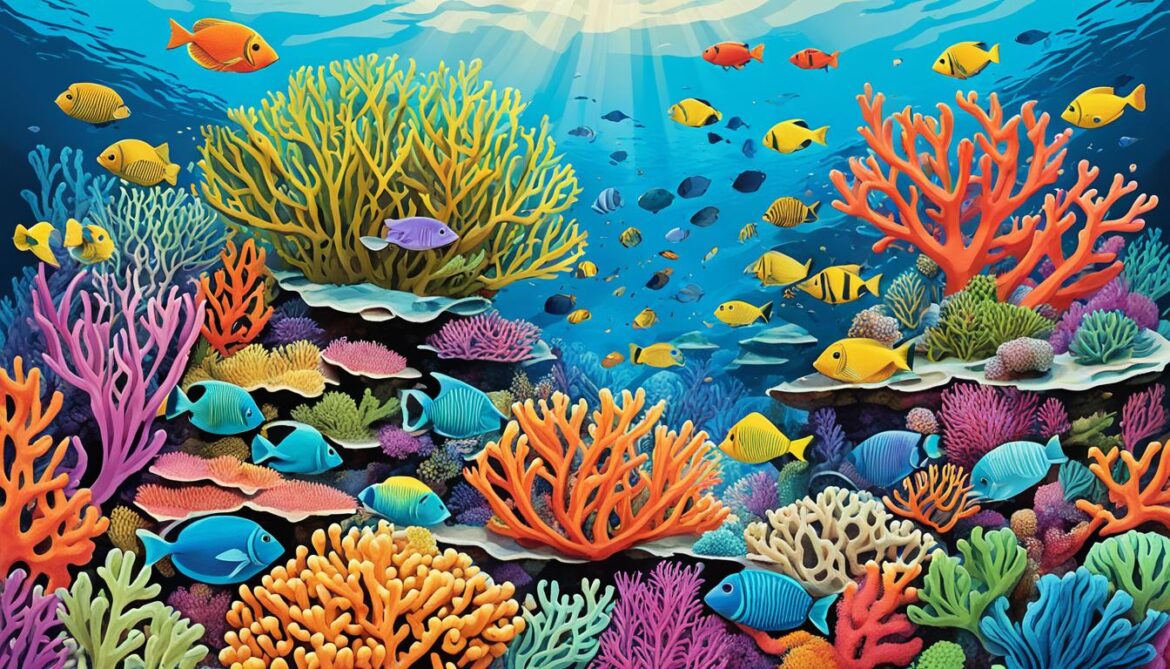
| Key Findings of Dr. Catherine Kim’s Research on Timor-Leste’s Coral Reefs |
| Timor-Leste’s coral reefs harbor high biodiversity, contributing to the richness of the Coral Triangle. |
| Lower levels of bleaching have been observed in Timor-Leste’s reefs, suggesting their potential as climate refuges for corals. |
| Protecting Timor-Leste’s coral reefs is crucial for preserving biodiversity, supporting sustainable fisheries, and ensuring the well-being of coastal communities. |
Traditional Practices and Conservation Efforts in Timor-Leste
Before the introduction of religious beliefs, Timor-Leste’s culture was based on animistic beliefs, which emphasized the connection between people and nature. This belief system recognized the intrinsic value of the environment and the importance of living in harmony with it. Animistic beliefs in Timor-Leste fostered a deep respect for nature and instilled a sense of responsibility towards its conservation.
One of the traditional practices that continues to play a significant role in traditional land and resource management in Timor-Leste is the implementation of Tara Bandu. Tara Bandu is a customary law that has been passed down through generations, guiding the sustainable use of land and resources. It serves as a framework for communal decision-making, ensuring that natural resources are protected and managed in a manner that promotes ecological balance and the well-being of local communities.
“Tara Bandu is not just a set of rules; it is a way of life that safeguards our environment and preserves our cultural heritage,” says Maria da Silva, a community leader in Timor-Leste.
The implementation of Tara Bandu involves a series of rituals and traditional customs that underscore the spiritual and sacred connection between the people and their land. These rituals serve as reminders of the collective responsibility to preserve and protect their environment for future generations. By respecting the boundaries set by Tara Bandu, communities work together to mitigate the negative impacts of human activities on the ecosystem.
Cultural Significance of Tara Bandu
Tara Bandu not only contributes to the sustainable management of natural resources but also preserves the cultural identity and heritage of the Timorese people. It represents a holistic approach to conservation that incorporates social, cultural, and environmental considerations.
“Tara Bandu is the manifestation of our profound respect for the land and all living beings. It is a living testament to our ancestors’ wisdom,” explains Mateus Guterres, a cultural anthropologist researching traditional practices in Timor-Leste.
The rituals associated with Tara Bandu are often performed at sacred natural sites, which are considered the dwelling places of ancestral spirits. These sites hold a special significance in the lives of the local communities, and their protection is central to the traditional land and resource management in Timor-Leste.

The Role of Community in Conservation
Tara Bandu is not solely enforced by external authorities but is primarily driven by the local communities themselves. The success of this traditional practice relies on the active participation and ownership of the community members. Timorese people understand that the responsibility for environmental conservation lies in their hands, and they take pride in upholding the values and customs passed down by their ancestors.
Community-led conservation efforts have led to the establishment of protected areas and the conservation of biodiversity hotspots. These areas are managed collectively by the community, who enforce rules and regulations to safeguard the integrity of the ecosystems. The principles of Tara Bandu form the foundation of these initiatives, ensuring that decisions are made in the collective interest and in accordance with the long-standing cultural and environmental values.
| Benefits of Tara Bandu |
Examples of Implementation |
- Promotes sustainable resource management
- Preserves cultural heritage
- Fosters community cohesion
|
- Misool Eco Resort Collaborative Conservation Initiative
- Lautem Bay Conservation Initiative
- Ataúro Island Community Conservation Area
|
The success of Tara Bandu as a conservation tool lies in its ability to integrate traditional land and resource management in Timor-Leste with contemporary conservation practices. The government of Timor-Leste recognizes the value of this traditional practice and has taken steps to incorporate it into the legal framework for environmental management.
Through the recognition and support of ancestral wisdom and traditional practices, Timor-Leste demonstrates its commitment to sustainable development and the preservation of its cultural and environmental heritage.
Uma Lisan/Lulik: Traditional Houses and Cultural Heritage
Timor-Leste’s cultural heritage is deeply rooted in the traditional houses known as uma lisan/lulik. These houses hold immense significance for each clan in the Makasae-speaking community, serving as cultural and heritage centers that uphold ancestral traditions and customs.
The uma lisan/lulik are led by lia nain, the respected traditional elders who play a pivotal role in preserving and passing on the cultural heritage of the community. Before the construction of these traditional houses, rituals are performed to invoke blessings and protection, ensuring a strong foundation rooted in spirituality.
These traditional houses not only serve as physical structures but also as symbols of identity and collective memory. They stand as a testament to the rich cultural heritage and deep connection between the Makasae-speaking community and their ancestral roots.
Within the uma lisan/lulik, specific rules and prohibitions govern what can be consumed. These practices reinforce the importance of respecting traditions and maintaining the sanctity of these cultural spaces.
The uma lisan/lulik play a vital role in preserving the intangible heritage of Timor-Leste. They provide a platform for transmitting traditional knowledge, stories, and values from one generation to the next. These traditional houses foster a sense of belonging, unity, and pride among the Makasae-speaking community.
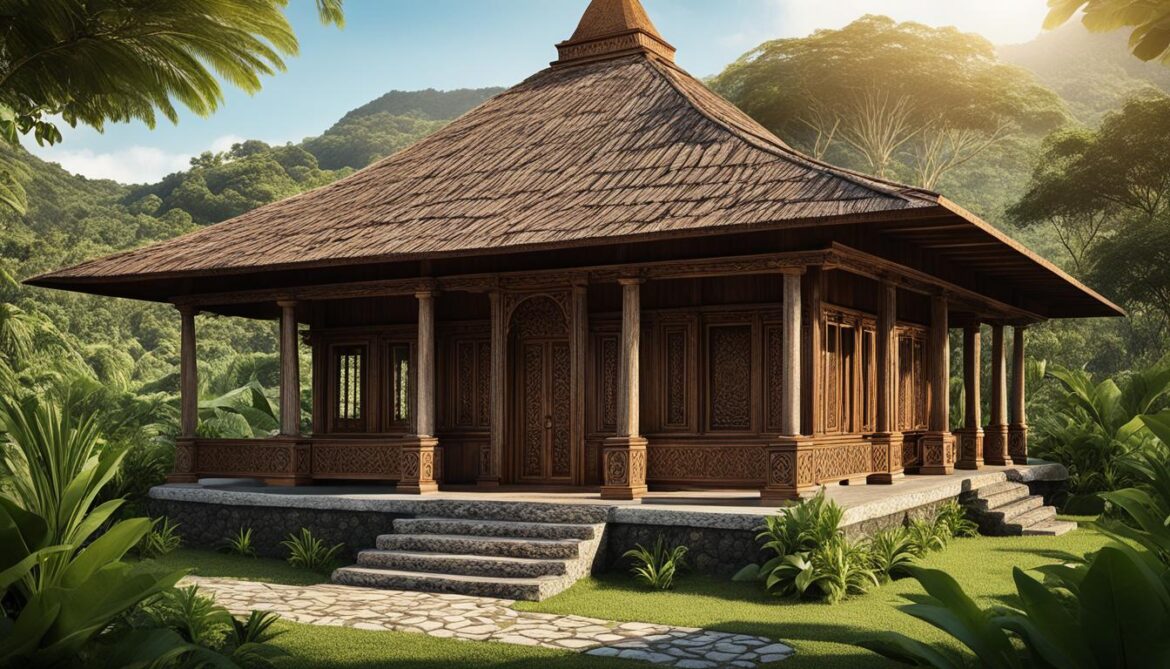
| Key Features of Uma Lisan/Lulik |
Significance |
| Architectural design with intricate carvings |
Reflects the community’s skilled craftsmanship and artistic traditions |
| Central gathering space for cultural events and ceremonies |
Fosters community cohesion and the preservation of ancestral practices |
| Storage of sacred objects and cultural artifacts |
Protects and honors cultural heritage, contributing to collective memory |
| Centers for transmitting traditional knowledge and skills |
Promotes intergenerational learning and ensures the continuity of cultural practices |
Preserving Cultural Heritage for the Future
The uma lisan/lulik stand as a testament to the resilience and commitment of the Makasae-speaking community in preserving their cultural heritage. These traditional houses serve as living testimony to the values, customs, and beliefs that have shaped the identity of the community.
By recognizing the significance of uma lisan/lulik and embracing their role as cultural and heritage centers, Timor-Leste ensures the preservation of its rich cultural legacy for future generations.
Handmade Goods and Traditional Clothing in Timor-Leste
Tais weaving in Timor-Leste is a cherished tradition that has been passed down through generations. These traditional hand-woven fabrics hold immense cultural and historical significance, representing the identity of the Timorese people. Tais is more than just a piece of cloth; it is a work of art that showcases the diversity of craftsmanship in the country.
Each municipality in Timor-Leste has its unique designs and motifs, making every Tais fabric a distinct representation of the local community. The intricate patterns, vibrant colors, and symbolic motifs tell stories of the region’s heritage and traditions. From geometric shapes to floral patterns, every Tais design has a story to tell.
Besides Tais, Timor-Leste is also known for its traditional goods made from palm fronds and coconut shells. These materials are creatively transformed into baskets, bowls, and household items, showcasing the local skills and creativity of the Timorese people. These handmade goods not only serve practical purposes but also reflect the deep connection between the people and their natural resources.
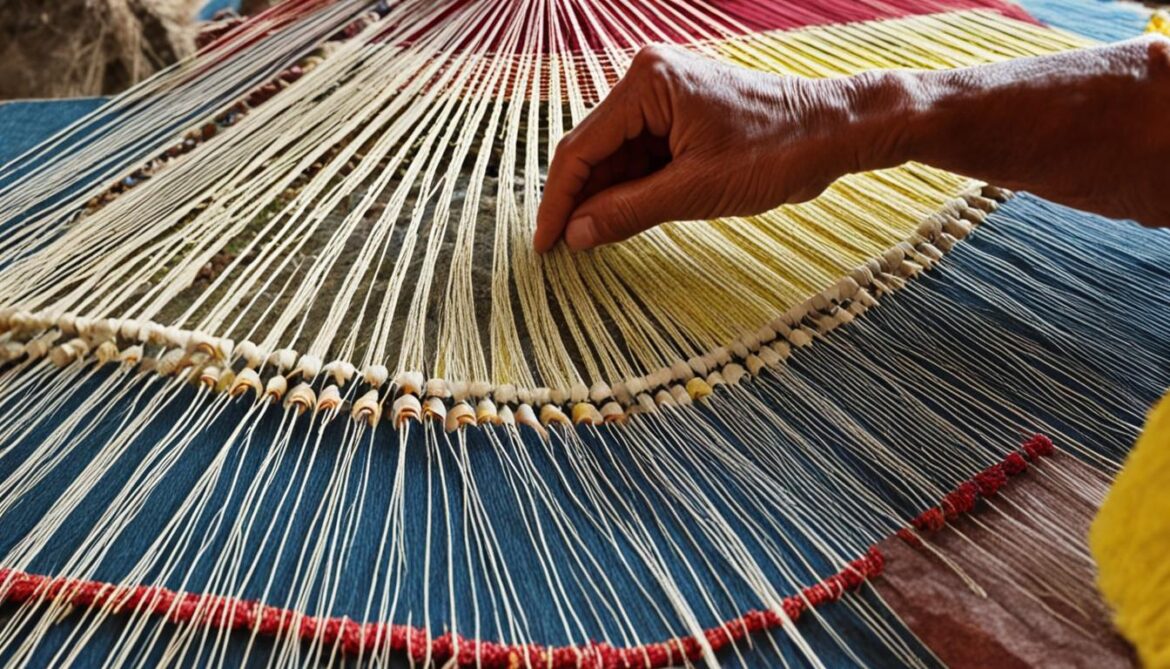
Whether it’s a hand-woven Tais fabric or a unique handmade object, these traditional goods play a vital role in preserving the cultural heritage of Timor-Leste. They serve as symbols of identity, tradition, and pride, bridging the past and the present. By embracing and promoting these traditional crafts, Timor-Leste nurtures a sense of community and fosters cultural appreciation.
Indigenous Knowledge and Climate Action in Timor-Leste
Local Timorese communities have sustained indigenous knowledge in Timor-Leste that has been passed down through generations. This wealth of wisdom informs their resilience to climate change and shapes their local adaptation practices in Timor-Leste. These traditional practices, such as customary laws and rituals, have played a significant role in supporting conservation efforts and facilitating adaptation to the changing climate patterns in the region.
The indigenous communities in Timor-Leste possess a deep connection to nature, rooted in their ancestral wisdom and cultural traditions. This connection serves as a foundation for climate action and the conservation of Timor-Leste’s biodiversity. By drawing upon their traditional knowledge, these communities are able to navigate the challenges posed by climate change and contribute to the sustainable development of the region.
“Our indigenous knowledge teaches us the importance of balance and harmony with the environment. By respecting and preserving nature, we ensure the well-being of future generations.” – Traditional Elder
Through indigenous knowledge, local communities have developed conservation practices that are uniquely adapted to the Timor-Leste context. These practices include sustainable land management techniques, water conservation methods, and the protection of sacred natural sites. By integrating traditional conservation practices into modern approaches, Timor-Leste can foster a harmonious relationship between its people and the environment, ensuring the long-term well-being of both.
Examples of Indigenous Knowledge in Practice:
- Agroforestry systems that combine native tree species, food crops, and medicinal plants for sustainable agriculture
- Community-led reforestation efforts to restore degraded ecosystems and mitigate the impacts of climate change
- Traditional fishing practices that promote sustainable harvesting and protect marine biodiversity
These examples highlight the valuable contributions of indigenous knowledge to climate action and conservation in Timor-Leste. By recognizing, respecting, and incorporating this knowledge into policies and initiatives, Timor-Leste can unlock the full potential of its rich cultural heritage and pave the way for a sustainable and resilient future.
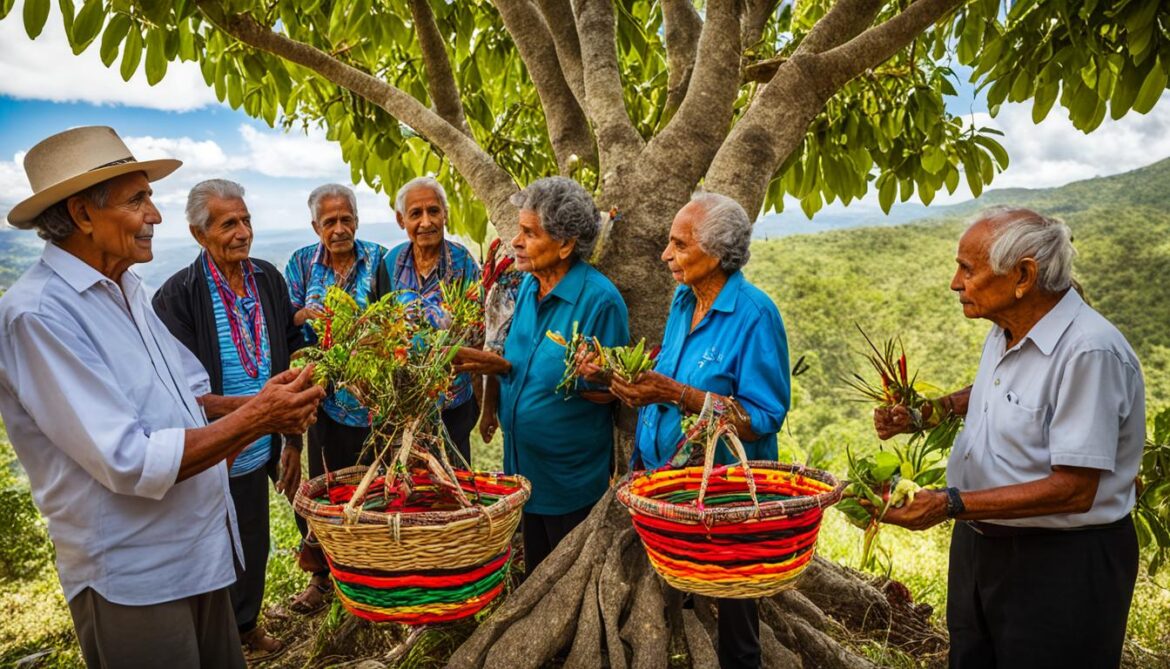
Traditional Conservation Practices in Timor-Leste
| Conservation Practice |
Description |
| Tara Bandu |
A customary law that regulates the use of natural resources and establishes rules for their sustainable management. |
| Taboos and Rituals |
Specific cultural practices and rituals performed to protect and respect sacred natural sites, ensuring their long-term preservation. |
| Community Forests |
Collective management of forests by local communities, integrating traditional knowledge to promote sustainable land use and conservation. |
The Importance of Local Knowledge and Practices in Addressing Climate Change
Timor-Leste recognizes the importance of local knowledge and practices in effective climate change adaptation and mitigation. By incorporating customary law and traditional customs into national policies, the country highlights the significant role of indigenous practices in modern environmental efforts.
The deep-rooted ancestral wisdom passed down through generations provides valuable insights and strategies for facing the challenges of climate change. The traditional knowledge encompasses various aspects, such as sustainable land management, natural resource conservation, and harmonious coexistence with the environment.
These local practices not only foster the preservation of Timor-Leste’s diverse ecosystems but also empower communities to adapt and mitigate the impacts of climate change. By valuing and embracing this indigenous wisdom, Timor-Leste strengthens its ability to protect its environment and ensure a sustainable future for generations to come.
Integration of Indigenous Practices in Conservation Efforts
“The integration of indigenous practices in conservation efforts is crucial for ensuring the long-term resilience of Timor-Leste’s biodiversity and ecosystems,” says Dr. Maria da Silva, a renowned environmental researcher. “Through the incorporation of traditional knowledge and local practices, we can develop effective strategies that balance human needs and environmental sustainability.”
The traditional practices encompass a range of activities, from sustainable farming techniques and traditional fishing methods to the protection of sacred natural sites. These practices promote the conservation of biodiversity, sustainable resource management, and the preservation of cultural heritage.
For instance, the Tara Bandu system, a customary law in Timor-Leste, plays a significant role in natural resource management. It involves community-led initiatives, regulations, and rituals aimed at maintaining the balance between human activities and the environment. These practices contribute to biodiversity conservation and support local communities’ adaptive capacity in the face of changing climatic conditions.
The Role of Indigenous Knowledge in Climate Resilience
Indigenous knowledge provides valuable insights into local climate patterns, ecosystem dynamics, and traditional coping mechanisms. The intergenerational knowledge transfer equips communities with the skills and strategies necessary to adapt to changing environments.
Local communities have developed innovative agricultural practices, water management systems, and climate-responsive livelihood strategies. They have cultivated crops that are resilient to extreme weather conditions and devised water conservation techniques that ensure sustainable access to water resources.
These indigenous practices not only enhance community resilience but also contribute to broader climate change adaptation efforts. The integration of local knowledge in national climate policies can inform the development of context-specific strategies that are sensitive to the unique ecological and cultural contexts of Timor-Leste.
Building a Sustainable Future through Local Knowledge
Timor-Leste’s commitment to the importance of local knowledge and practices reflects its holistic approach towards climate change adaptation and mitigation. By recognizing and supporting the preservation of indigenous practices, the country fosters a harmonious relationship between human activities and nature.
Embracing the knowledge and practices of local communities empowers them to actively participate in environmental conservation and sustainable development. The involvement of indigenous communities in decision-making processes ensures that climate change strategies are inclusive, equitable, and effective.
Through a collaborative effort that values the role of indigenous practices, Timor-Leste can navigate the challenges of climate change and create a sustainable future for its people and the planet.
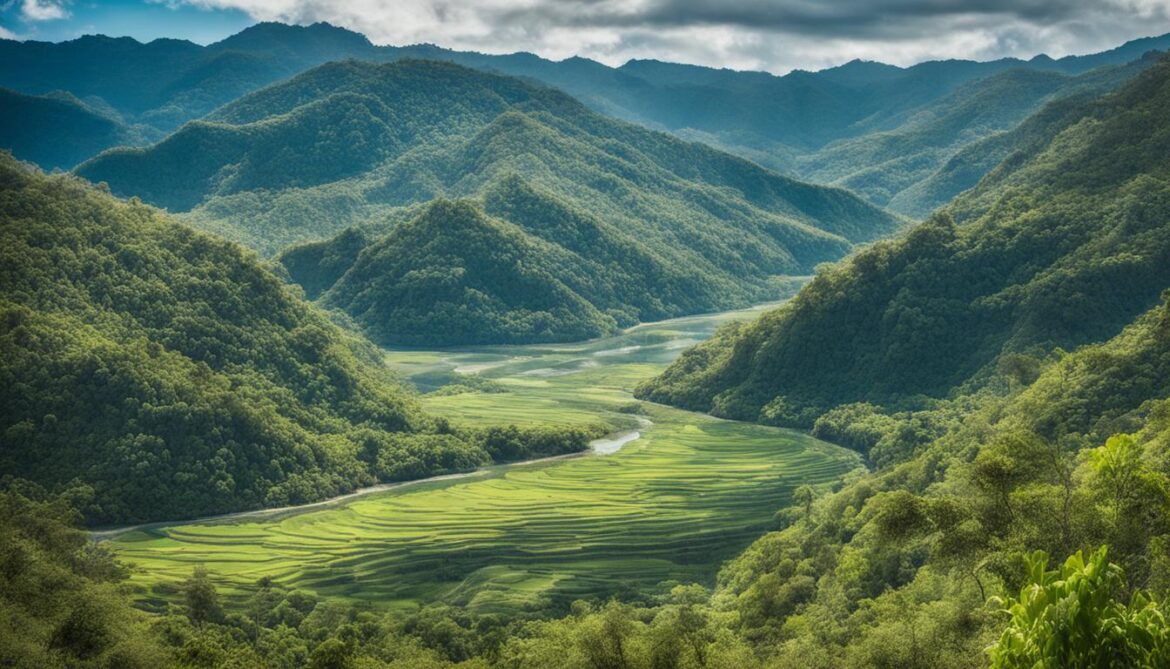
The Importance of Local Knowledge and Practices
The table below illustrates the tangible benefits of integrating local knowledge and practices in climate change adaptation and mitigation efforts:
| Benefits |
Examples |
| Informed decision-making |
Indigenous communities’ local knowledge informs climate adaptation strategies tailored to the specific needs of their ecosystems. |
| Sustainable resource management |
Traditional practices such as rotational farming and conservation of sacred sites promote the sustainable use of natural resources. |
| Resilience to climate change |
Indigenous knowledge equips communities with adaptive strategies to cope with changing climatic conditions, ensuring food security and water availability. |
| Cultural preservation |
By valuing indigenous practices, Timor-Leste preserves its rich cultural heritage and fosters a sense of identity and belonging within local communities. |
| Community empowerment |
Recognizing local knowledge and practices empowers communities to take an active role in climate action, promoting inclusive and sustainable development. |
Conclusion
Timor-Leste’s commitment to the protection of its sacred natural sites and biodiversity is evident through its conservation efforts and the implementation of the National Biodiversity Strategy and Action Plan. These strategies provide a framework for the sustainable use and preservation of the country’s rich environmental heritage.
The integration of indigenous knowledge and local practices in climate action further strengthens Timor-Leste’s resilience in the face of climate change. By leveraging traditional wisdom and embracing ancestral connections to nature, the country is better equipped to adapt and mitigate the impacts of a changing climate.
By valuing and preserving its cultural and environmental heritage, Timor-Leste paves the way for a sustainable future. The combination of conservation efforts, indigenous knowledge, and climate action creates a holistic approach to protecting the unique biodiversity of East Timor and ensuring the well-being of its people and the planet.
FAQ
What is the National Biodiversity Strategy and Action Plan of Timor-Leste?
The National Biodiversity Strategy and Action Plan of Timor-Leste (2011-2020) is a comprehensive plan prepared by the National Biodiversity Working Group to conserve and wisely use the country’s biodiversity and ecosystems. It focuses on understanding biodiversity wealth, implementing conservation strategies, capacity development, and coordination mechanisms.
What makes Timor-Leste’s coral reefs special?
Timor-Leste is home to the most biodiverse coral reefs in the world. These reefs are part of the Coral Triangle, known as the most biodiverse marine ecosystem globally. Timor-Leste’s reefs also exhibit lower levels of bleaching compared to other reefs, indicating a possible climate refuge for coral reefs.
How is Timor-Leste addressing conservation challenges and climate change?
Timor-Leste recognizes the importance of conserving its coral reefs for the future generation and the tourism industry while maintaining sustainable livelihoods for local communities. The government aims to develop eco-tourism in a natural and environmentally friendly way, avoiding the commercialization seen in other tourist destinations. This approach addresses conservation challenges and climate change concerns.
Who is Luis Melky Here-Huno and what is his role in Timor-Leste’s sustainable tourism?
Luis Melky Here-Huno is the first qualified diving instructor in Timor-Leste. He started as a garbage collector in Dili and now teaches diving to Timorese children. Melky aims to educate locals about the value of the ocean and the need to protect coral reefs. His efforts have earned him recognition as a tourism champion, highlighting the importance of sustainable tourism in Timor-Leste.
What is Dr. Catherine Kim’s research contribution to Timor-Leste’s biodiversity?
Dr. Catherine Kim conducted extensive research on Timor-Leste’s coral reefs, contributing to the understanding of the country’s unique biodiversity. Her research revealed the high biodiversity of Timor-Leste’s reefs, which are part of the Coral Triangle, recognized as the most biodiverse marine ecosystem in the world. Dr. Kim also found that Timor-Leste’s reefs exhibited lower levels of bleaching compared to other reefs, indicating a possible climate refuge for coral reefs.
How do traditional practices contribute to conservation efforts in Timor-Leste?
Before the introduction of religious beliefs, Timor-Leste’s culture was based on animistic beliefs that emphasized the connection between people and nature. Traditional practices like Tara Bandu, a customary law to conserve the environment, play a significant role in natural resource management. The local people perform rituals and house traditional customs to ensure the sustainable use of land, protect sacred natural sites, and maintain the balance between human activities and the environment.
What are Uma Lisan/Lulik and their significance in Timor-Leste?
Uma Lisan/Lulik are traditional houses in Timor-Leste. Each clan has its own traditional house, which serves as a cultural and heritage center. Led by lia nain (traditional elders), these houses uphold ancestral traditions and customs. Rituals are performed before constructing these houses, and there are specific rules and prohibitions on what can be consumed within the clan. These traditional houses are essential in preserving and passing on the cultural heritage of the Makasae-speaking community.
What are some traditional handmade goods in Timor-Leste?
Tais, traditional hand-woven fabrics, are an integral part of Timor-Leste’s culture and identity. Each municipality has its unique designs and motifs, showcasing the diversity of craftsmanship in the country. Additionally, traditional goods made from palm fronds and coconut shells reflect the local skills and creativity of the Timorese people.
How does indigenous knowledge contribute to climate action in Timor-Leste?
Local Timorese communities have sustained indigenous knowledge passed down through generations, which informs their resilience to climate change. Traditional practices, such as customary laws and rituals, support conservation efforts and adaptation to changing climate patterns. The connection to nature and ancestral wisdom provide a foundation for climate action and the conservation of Timor-Leste’s biodiversity.
Why is local knowledge and practices important in addressing climate change?
Timor-Leste recognizes the importance of local knowledge and practices in addressing climate change. By incorporating customary law and traditional customs into national policies, Timor-Leste highlights the significance of ancestral wisdom in modern adaptation and mitigation efforts. By acknowledging and embracing this local knowledge, Timor-Leste can better protect its environment and tackle the challenges posed by climate change.
How do Timor-Leste’s conservation efforts contribute to the protection of sacred natural sites and biodiversity?
Timor-Leste’s conservation efforts, supported by strategies such as the National Biodiversity Strategy and Action Plan, demonstrate the country’s commitment to protecting its sacred natural sites and biodiversity. The integration of indigenous knowledge and local practices in climate action further strengthens Timor-Leste’s ability to adapt and mitigate the impacts of climate change. By valuing and preserving its cultural and environmental heritage, Timor-Leste can create a sustainable future for its people and the planet.
Source Links






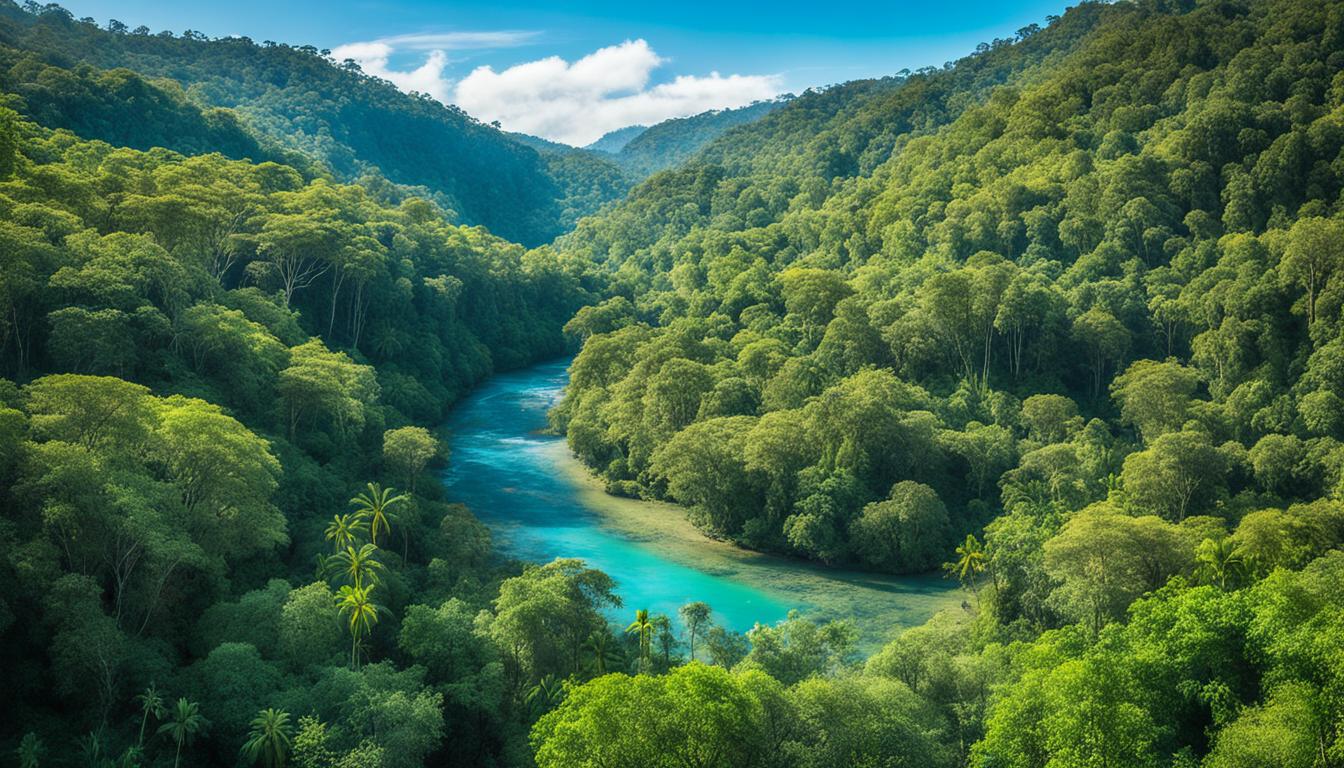


















Post comments (0)